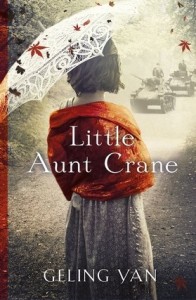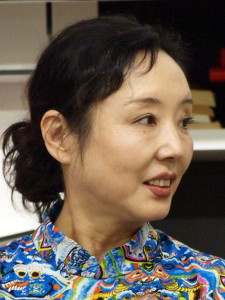What War Does to Human Hearts: Interview with Geling Yan
- By Guest blogger
- 30 April, 2016
- No Comments
The Second Sino-Japanese War formed the backdrop for Chinese-born author Geling Yan’s novella 13 Flowers of War, which was adapted for the big screen as The Flowers of War. Now the legacy of the war has inspired yet another work by the author. In this interview with Karen Ma she shares her thoughts about her art and “what war does to human hearts.” The interview is reproduced with the kind permission of ChinaFile, one of the very best online magazines about all aspects of China. The original interview can be accessed here.
Award-winning screenwriter and author Geling Yan has written more than 20 novels and short story collections about China, many adapted to film or TV, including Coming Home and The Flowers of War, both of which became feature films directed by Zhang Yimou. But the novel Little Aunt Crane was one of her most difficult to complete, the seasoned Chinese-American writer admits. The epic tale, just released in English translation in December, centers on a 16-year-old Japanese orphan’s bid to survive after she’s sold to a Chinese family in Manchuria as a second wife to bear children for the son and his infertile spouse at the end of the horrific Sino-Japanese War.
It took Yan more than two decades to muster enough courage to start writing the novel, she says. Part of her challenge was to relate this little-known corner of Sino-Japanese history in Manchuria, the region today known as Dongbei. After Japan’s military occupied Manchuria, between 1931 and 1932, historical-anthropologist Mariko Asano Tamanoi estimates some 2.2 million Japanese settled or were stationed there with the army by 1945. When the Soviet military invaded in late 1945, these Japanese civilians became easy targets. Thousands of these migrants were used as pawns in defense of the Japanese mainland and were subsequently abandoned by the Japanese military when it became clear the war was lost. Many of those who were abandoned died from hunger, disease, or compulsory group suicide. The estimated death toll, according to Tamanoi’s research, almost matches that of those who perished from the atomic bombings of Hiroshima and Nagasaki.
Yan, who now lives in Germany, was recently in Beijing to promote the novel’s English edition, which was released by the British publisher Harvill Secker. In an email interview with writer Karen Ma, conducted in English, she discussed how she wrote the novel, the challenges she faced portraying a character on the wrong side of history, and her interest in writing about a difficult chapter in the shared history of China and Japan.
Little Aunt Crane is a story that revolves around a mysterious young Japanese girl displaced by war and left behind in Manchuria in the aftermath of World War II. Can you explain why you were drawn to this story and this particular character in the first place?
Many years ago, one of my childhood friends sent down with her family to a small industrial city told me a story about twin brothers in her class who intrigued her. Her classmates discussed them behind their back, saying that there was a woman in their house besides their mother who seemed to have a mysterious position in their family, and this woman would kneel down to tie the boys’ father’s shoelaces and make everybody take off their shoes before entering the house. Later, my friend and her classmates discovered that this mysterious woman was not Chinese but Japanese [and] was sold to this family in a sack during the Japanese retreat from China, and she was the twins’ natural mother. I was amazed by the story and couldn’t help imagining how all them had lived in secrecy and harmony in a Chinese neighborhood. After I moved to the U.S., I told the story to many friends in artistic and literary circles, and they seemed very interested. One of my author friends even bought me a kimono to encourage me to write the story, but not until 2007 did I muster enough courage to create a novel whose main female character was Japanese. And also what made it possible to carry out the expensive research trips in Japan was that [my husband and I] moved to Taiwan in 2006. By then our financial situation allowed me to do the research in Japan. After my second trip, I started to write this novel.
Can you tell us a bit about your research trips and your interviews with the war-displaced women in Japan?
Yes, I made three trips to Japan, two to Nagano Prefecture and one to Okinawa. With friends’ help, I was able to meet a nurse who helped repatriate many Japanese women left behind after the war and taken in by Chinese families either as daughters or as wives. And through this nurse I interviewed the Japanese women who had returned from China. These women, all in their eighties, told me about their life experiences, marrying Chinese men or being adopted into Chinese families as maids or daughters. Their stories were so touching that they moved me to tears. After my first trip to Japan, I thought I had enough material to write, but then I realized I still didn’t have enough [of an emotional connection] to portray a Japanese person, so I went to Nagano Prefecture again. This time, my confidence in creating a Japanese female character increased. My trip to Okinawa was not for the purpose of research but for vacation. Nonetheless, it helped a lot as I visited the war memorial museum, where I got to know the tragic historical fact that more than two hundred female students of a high school who served as nurses to Japanese soldiers died at the defeat of the island, many of them by committing suicide. The youngest of them was only 15. Looking at each of their photos hanging on the wall, I felt inspired. They gave me some symbolic understanding to the character of Japanese women.
 This isn’t the first time you’ve written about a character that is not Chinese—in Flowers of War we meet an American priest by the name of Father Engelmann, for example. But did you find the portrayal of Crane somehow more challenging, despite all of the research you did?
This isn’t the first time you’ve written about a character that is not Chinese—in Flowers of War we meet an American priest by the name of Father Engelmann, for example. But did you find the portrayal of Crane somehow more challenging, despite all of the research you did?
It’s always challenging to portray foreign characters in a novel that is told mainly from a Chinese perspective or, you may say, in a Chinese story. That’s why it took me more than 20 years to muster my courage to start this novel. I am still amazed by how [I portrayed] Crane, my first and maybe last Japanese female character. The hardest part of creating Crane [was] to get into her mind, diving deep into her emotions, and seeing the world full of foreigners who used to be her country’s victims through her eyes. It is very hard to convince myself that Crane is “Japanese” enough, much less convince my readers. Only when I heard a Japanese woman working as a translator between Chinese and Japanese say she was moved by my novel, when the book had just come out, did I believe I did a fairly good job portraying Crane.
You’ve been described as a writer of the “hidden” art. From The Ninth Widow to Flowers of War, and now Little Aunt Crane, we meet many women characters that have to conceal their identities, figuratively or literally, again and again. Can you explain why you’re so drawn to characters who have to live in a lie and “hide” from the public eye?
First, I have to laugh at your description of me as a “writer of the art of the hidden.” The three novels you mentioned are indeed about characters in hideouts or hiding in false identities, but again, during all the political campaigns of the past century in China, who didn’t hide in false identities? When one can’t show one’s real self, and tells nothing but lies, can I say they hide in their false identities? That is what Chinese people are, always hiding in what they are not.
In the story, Crane, the protagonist, is sold by human traffickers to a Chinese family and is forced to become their son’s secret second wife and bear his children. From what you know, was this practice of Chinese families’ buying young trafficked Japanese women as “borrowed wombs” common at the time?
I don’t know if this story is common or not. But many young Japanese women left behind after the war were married into Chinese families. Their families exchanged them for food and money, in order to allow the rest of the family to make it back to Japan. This situation was common during the time after the war.
You repeatedly write about women who are survivors of extreme situations, from war refugees to prostitutes to social underdogs. And you write about them with such empathy and understanding. To what extent does this have to do with your tough upbringing under the uncertain political climate of China, and your experience as an overseas writer who has to reckon constantly with her minority status?
I think it has everything to do with my tough upbringing. When the Cultural Revolution took place, I was seven, and it was the beginning of human nature playing itself out before my eyes. And because my father had an unpopular political status, I was ostracized and felt very [out of place]. So when I moved to the United States, it didn’t bother me a bit to be alone and marginalized. I believe all free thinkers, all artists and writers, should be independent from the mainstream so they won’t take the value system or moral standards of the mainstream for granted. They should take it as their duty to question and doubt the way of life and way of thinking of the majority. I am glad to live overseas as a Chinese writer, to remain independent and critical of both sides.
China and Japan continue to suffer tense relations long after the war. You’ve written an amazingly sensitive and powerful story that has this relationship as a backdrop. How much did the broader tension and misunderstanding affect your decision to choose this period, these characters?
Political and diplomatic relations between Japan and China didn’t affect my choice of subject matter at all. Remember, I heard these war stories back in the ’80s, when these two wary neighbors had just reconciled. What makes me choose to write a particular story as fiction only depends on how interesting the story is and how much literary and aesthetic value I can see in it. In China, I don’t believe there are enough good literature and artistic works of aesthetic value that have been created on this war. So far, most are just crass propaganda. Literature doesn’t stop war, but it helps us understand what war can do to human hearts, and what worst or best behaviors war can trigger from us.





 Copyright © 2024
Copyright © 2024
Leave a Reply